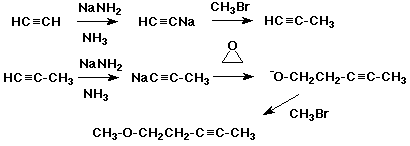Organic Chemistry II
Dr. Carl C. Wamser
1. (12 points) Write a complete name for each of the following compounds, including designation of stereochemistry if it is specifically shown:
a) 
(R)-4-cyclopentylbut-3-yn-2-ol
b) 
cis-4-ethoxycyclohexanol
c) 
(2R,3R)-2-ethyl-2,3-dimethyloxirane
2. (15 points) Write accurate structures that illustrate each of the following:
a) the enol tautomer of cyclopentanone
![]()
b) 15-crown-5

c) 1,1-dimethylallene
![]()
d) ethyl trimethylsilyl ether
![]()
e) 1,4-dioxane
![]()
3. (15 points) Complete each of the following reactions by adding the missing part: either the starting compound, the necessary reagents and conditions, or the final major product. Indicate stereochemistry if it is specific.
a) 
b) 
c) 
d) 
e) 
4. (20 points) Write a balanced reaction for hydration of 2-methyloxirane (propylene oxide) to 1,2-propanediol.
![]()
If the starting 2-methyloxirane is optically active, the
optical activity of the product depends on whether the reaction
is carried out under acidic or basic conditions.
Start with (R)-2-methyloxirane and write complete mechanisms for
both the acid and base-catalyzed hydration, in particular pointing
out how the different stereochemistry occurs. Show all steps and
all intermediates involved.

In base, OH- is a strong nucleophile that attacks the less-substituted carbon as in a typical SN2 reaction. The chiral center is not affected.
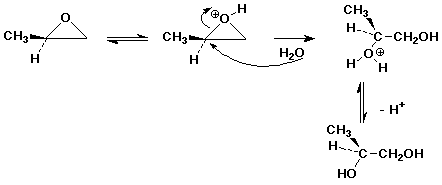
In acid, H2O is a weak nucleophile that attacks the more-substituted carbon because it bears a greater + charge. The chiral center is inverted.
5. (16 points) Refer to the mass spectral data summarized below and deduce at least one likely structure for each compound. Identify the structures of the indicated fragment peaks.
a) Compound A:
M+2 at 80, intensity 8
M at 78, intensity 24
base peak at 43, intensity 100
The M and M+2 peaks indicate the presence of Cl. The rest of the molecule appears at 43, which is C3H7, either 1-propyl or 2-propyl.
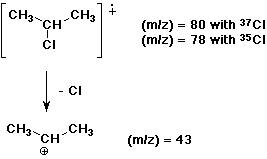
b) Compound B:
M at 56, intensity 43
M-1 at 55, intensity 21
base peak at 41, intensity 100
The absence of a significant M+2 peak indicates no Cl or Br. The 41 peak is most likely allyl, a very stable cation. The parent peak is allyl plus a methyl.
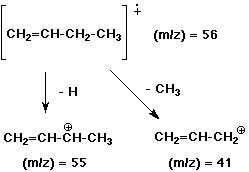
6. (10 points) The synthetic conversion shown below will
require a protecting group. Explain why this would be necessary
and show a sequence of reactions that could accomplish the conversion.
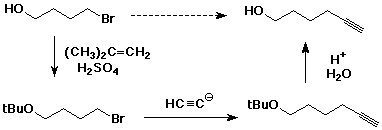
7. (12 points) Write out a sequence of reactions that could be used to accomplish each of the following syntheses. Show the necessary reagents and conditions for each reaction step, but do not show mechanisms. Use acetylene, ethylene oxide (oxirane), and methyl bromide as the only source of carbons.
a) ![]()
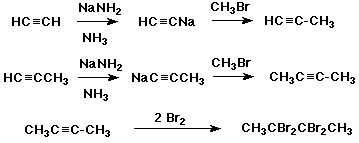
b) 
